Why go to the moon? Simple. To keep civilization as we know it from collapsing. Is that too much to ask?
Over the last couple of weeks, I've explained how Mars first reached mythical status in the late nineteenth and early twentieth centuries as a desirable planet for people to visit and even live by a series of books and lectures by a somewhat crazy billionaire turned astronomer named Percival Lowell. https://homerhickamblog.blogspot.com/2019/06/a-myth-known-as-mars-psst-nasas-not.html
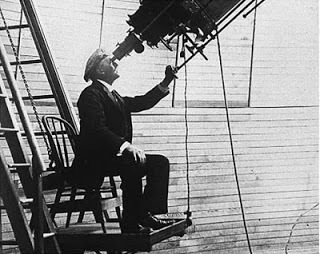 Percival Lowell, billionaire, astronomer, and kinda crazy
Percival Lowell, billionaire, astronomer, and kinda crazy
After that, I examined what it would actually take to send humans to Mars and my belief that NASA will not ever attempt it nor will anyone else who's reasonable because this tiny little planet isn't worth the blood, time, or treasure to send humans there when robotic and artificial intelligence is available to thoroughly explore it and get back all the answers it might hold. https://homerhickamblog.blogspot.com/2019/07/mars-is-not-for-humans-not-now-and.html
 Earth
Earth
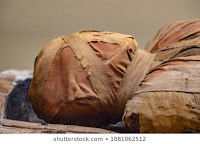 Mars
Mars Artificial Intelligence (AI) Buffy
Artificial Intelligence (AI) Buffy
But this isn't true for Luna, our moon. It's different. People not only can go there, they should go because we need their intelligence, their labor, and their sweat to pretty much save the world. This concept, however, seems to be beyond the capability of some folks to understand or explain while to me, it's simple.
But maybe that's because of the unique place I'm from, a town called Coalwood in a state called West Virginia in a place called Appalachia where it's difficult to get there, difficult to live there, but has resources that must be shipped elsewhere in order to keep our civilization humming along.
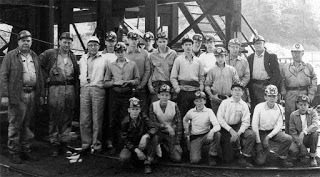 That's me, third from the right kneeling. Just us 9th grade boys
That's me, third from the right kneeling. Just us 9th grade boys
after visiting the mine where our dads worked
In other words, I'm from a place something like the moon.
West Virginians came to the mountain state in the early 20th Century attracted by the coal mining industry. It wasn't that they necessarily liked mining coal. They came so as to make money and have a place where they could raise their families. The work they did was nasty and dangerous but they still did it and did it as long as they could. After awhile, it became their way of life and they fell in love with the mountains, hills, and valleys of the rugged land.
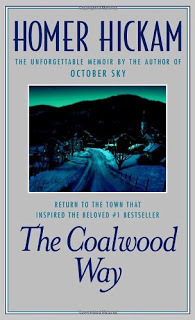 One of my memoirs about life in Coalwood
One of my memoirs about life in Coalwood
Their way of life is the way I think life on the moon could and should evolve.
A few years back, I wrote about the descendants of West Virginians in Crescent , the second novel in my "Crater" trilogy. In the 22nd Century, Crater, a young Helium-3 miner, and Crescent, a genetically modified female, meet a group on the moon who are fleeing from Earth because their land has been stolen. It turns out they are from an area in the former United States known as Appalachia which has been forcibly depopulated for socio-economic reasons. This is not too farfetched as much of the West Virginia county and the town of Coalwood where I grew up has been depopulated, the people forced to go elsewhere to find jobs. I am one of those ex-pats so I can relate to the group that Crater and Crescent agree to lead to a far place on the moon, a mining town called Endless Dust which is laid out somewhat like Coalwood.
Recently, I told Senator Ted Cruz and his Aviation and Space Subcommittee that what I want out of the space program is "Coalwood on the moon" and that I don't care two cents about who the next professional astronaut is who goes there. What I care about is opening a place where real people - plumbers, electricians, miners, construction workers, and other so-called blue collar workers - can go work, make money, and raise their families just like in the Coalwood where I grew up. Go here to see exactly what I said:
https://archive.org/details/CSPAN3_20190710_100600_Senate_Commerce_Subcommittee_on_NASA_Exploration
The moon I describe in Crater, Crescent, and The Lunar Rescue Company is a place where there are many Coalwoods, frontier mining towns populated by a rugged people made even tougher and stronger by the land in which they live.
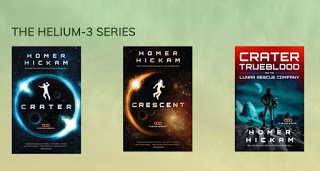 My "Crater" series of novels (aka Helium-3 series)
My "Crater" series of novels (aka Helium-3 series)
So how does that happen? How does the moon go from being an exotic fantastic locale where only brave astronauts dare to go to a place of work for folks like those who raised their families in Coalwood? And why would the taxpayers of the United States and our partners and allies ever want to shell out even a dime to make that happen?
Let's deal with the "why" which might be controversial - so be it - but the way I see things.
Earthian civilization in general is in a precarious position. Worldwide, from my study of what we're up to these days, it seems we have settled on a model for prosperity that has always worked for awhile, sometimes a good long while, but always inevitably contracts and collapses.
It is the model that Rome, both the Republic and the Empire, used which required gobbling up resources while expanding. When expansion stopped, it didn't equal stability for Rome. It meant contraction which meant dwindling resources which meant ultimate collapse.
 Hi there, how ya doin'?
Hi there, how ya doin'?
Good. Not starving and literate and ready to learn new stuff.
But we got slaves which ain't right.
I know. Maybe we'll get better.
Maybe, if we don't choke. You know, collapse and stuff. In the present situation across the world, such collapse of our economic model (so-called Communist and Socialist states essentially follow the same model although they claim not to) would likely mean exactly what happened in Europe after Rome went away, a long series of violent wars and rampant diseases. In modern times, that would be made all the worse by the loosing of nuclear weapons across the planet by zealots of all stripes.
Rome, for all its many faults, brought stability and the chance to make things better through the expansion of scientific knowledge and philosophy. Its collapse brought mostly misery for a good long while to everybody so we really don't want that to happen again if we can avoid it.
 We choked.
If we can't expand on Earth, the heavens come into play and there is only one place "up there" that qualifies as a reasonable place for the world to expand and gather resources.
We choked.
If we can't expand on Earth, the heavens come into play and there is only one place "up there" that qualifies as a reasonable place for the world to expand and gather resources.
Our moon.
So the "why" becomes simply this: We need to gather resources from the moon because if we don't, there's a good chance civilization as we know it will crumble. The stakes are that dire.
And what are those resources on the moon that the people of lunar Coalwoods will gather for us and send back? Well, what were the resources in the lands of the Louisiana Purchase before we sent Lewis and Clark out to discover them? We didn't know but we had faith there was plenty there and our faith was not misplaced but I'll give you the usual list: Platinum, Helium, Helium-3, Thorium, etc. etc. and so forth but remember beneath every crater is the shattered remains of an asteroid. There's likely gold in them thar lunar hills and a lot else, too.
As to the "how," it's also pretty simple. We as a nation - or perhaps as a civilization - need an anchoring base on the moon from which other entities, whether governmental or private, can come to, outfit and gird themselves, and then set across the lunar plains, valleys, rilles, and hills to explore and then build their roads and towns and start working and making money and raising their families and sending resources back to a needy Earth.
That's it. That's all our federal government has to do. Just build an anchor up there, one staging area and then hold onto it long enough for all others to follow and build up a lunar civilization based on gathering resources.
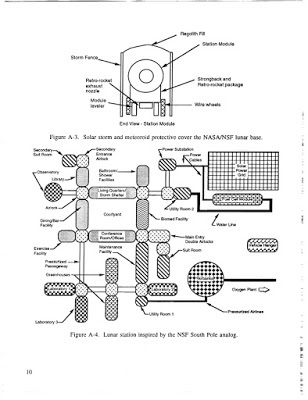 My clever little moon anchor as described in my 1993 (!) study for NASA
My clever little moon anchor as described in my 1993 (!) study for NASA
I kind of mapped that anchor out in my 1993 study which I cleverly disguised as a comparison with the South Pole Station that can be seen here: https://homerhickamblog.blogspot.com/2019/03/1993-study-of-moon-laboratory-by-homer.html
Building that anchor's not too much to save the world from centuries of pain and poverty, is it?
Is it?
We shall see.
 Percival Lowell, billionaire, astronomer, and kinda crazy
Percival Lowell, billionaire, astronomer, and kinda crazyAfter that, I examined what it would actually take to send humans to Mars and my belief that NASA will not ever attempt it nor will anyone else who's reasonable because this tiny little planet isn't worth the blood, time, or treasure to send humans there when robotic and artificial intelligence is available to thoroughly explore it and get back all the answers it might hold. https://homerhickamblog.blogspot.com/2019/07/mars-is-not-for-humans-not-now-and.html
 Earth
Earth Mars
Mars Artificial Intelligence (AI) Buffy
Artificial Intelligence (AI) BuffyBut this isn't true for Luna, our moon. It's different. People not only can go there, they should go because we need their intelligence, their labor, and their sweat to pretty much save the world. This concept, however, seems to be beyond the capability of some folks to understand or explain while to me, it's simple.
But maybe that's because of the unique place I'm from, a town called Coalwood in a state called West Virginia in a place called Appalachia where it's difficult to get there, difficult to live there, but has resources that must be shipped elsewhere in order to keep our civilization humming along.
 That's me, third from the right kneeling. Just us 9th grade boys
That's me, third from the right kneeling. Just us 9th grade boysafter visiting the mine where our dads worked
In other words, I'm from a place something like the moon.
West Virginians came to the mountain state in the early 20th Century attracted by the coal mining industry. It wasn't that they necessarily liked mining coal. They came so as to make money and have a place where they could raise their families. The work they did was nasty and dangerous but they still did it and did it as long as they could. After awhile, it became their way of life and they fell in love with the mountains, hills, and valleys of the rugged land.
 One of my memoirs about life in Coalwood
One of my memoirs about life in Coalwood
Their way of life is the way I think life on the moon could and should evolve.
A few years back, I wrote about the descendants of West Virginians in Crescent , the second novel in my "Crater" trilogy. In the 22nd Century, Crater, a young Helium-3 miner, and Crescent, a genetically modified female, meet a group on the moon who are fleeing from Earth because their land has been stolen. It turns out they are from an area in the former United States known as Appalachia which has been forcibly depopulated for socio-economic reasons. This is not too farfetched as much of the West Virginia county and the town of Coalwood where I grew up has been depopulated, the people forced to go elsewhere to find jobs. I am one of those ex-pats so I can relate to the group that Crater and Crescent agree to lead to a far place on the moon, a mining town called Endless Dust which is laid out somewhat like Coalwood.
Recently, I told Senator Ted Cruz and his Aviation and Space Subcommittee that what I want out of the space program is "Coalwood on the moon" and that I don't care two cents about who the next professional astronaut is who goes there. What I care about is opening a place where real people - plumbers, electricians, miners, construction workers, and other so-called blue collar workers - can go work, make money, and raise their families just like in the Coalwood where I grew up. Go here to see exactly what I said:
https://archive.org/details/CSPAN3_20190710_100600_Senate_Commerce_Subcommittee_on_NASA_Exploration
The moon I describe in Crater, Crescent, and The Lunar Rescue Company is a place where there are many Coalwoods, frontier mining towns populated by a rugged people made even tougher and stronger by the land in which they live.
 My "Crater" series of novels (aka Helium-3 series)
My "Crater" series of novels (aka Helium-3 series)
So how does that happen? How does the moon go from being an exotic fantastic locale where only brave astronauts dare to go to a place of work for folks like those who raised their families in Coalwood? And why would the taxpayers of the United States and our partners and allies ever want to shell out even a dime to make that happen?
Let's deal with the "why" which might be controversial - so be it - but the way I see things.
Earthian civilization in general is in a precarious position. Worldwide, from my study of what we're up to these days, it seems we have settled on a model for prosperity that has always worked for awhile, sometimes a good long while, but always inevitably contracts and collapses.
It is the model that Rome, both the Republic and the Empire, used which required gobbling up resources while expanding. When expansion stopped, it didn't equal stability for Rome. It meant contraction which meant dwindling resources which meant ultimate collapse.
 Hi there, how ya doin'?
Hi there, how ya doin'?Good. Not starving and literate and ready to learn new stuff.
But we got slaves which ain't right.
I know. Maybe we'll get better.
Maybe, if we don't choke. You know, collapse and stuff. In the present situation across the world, such collapse of our economic model (so-called Communist and Socialist states essentially follow the same model although they claim not to) would likely mean exactly what happened in Europe after Rome went away, a long series of violent wars and rampant diseases. In modern times, that would be made all the worse by the loosing of nuclear weapons across the planet by zealots of all stripes.
Rome, for all its many faults, brought stability and the chance to make things better through the expansion of scientific knowledge and philosophy. Its collapse brought mostly misery for a good long while to everybody so we really don't want that to happen again if we can avoid it.
 We choked.
If we can't expand on Earth, the heavens come into play and there is only one place "up there" that qualifies as a reasonable place for the world to expand and gather resources.
We choked.
If we can't expand on Earth, the heavens come into play and there is only one place "up there" that qualifies as a reasonable place for the world to expand and gather resources.Our moon.
So the "why" becomes simply this: We need to gather resources from the moon because if we don't, there's a good chance civilization as we know it will crumble. The stakes are that dire.
And what are those resources on the moon that the people of lunar Coalwoods will gather for us and send back? Well, what were the resources in the lands of the Louisiana Purchase before we sent Lewis and Clark out to discover them? We didn't know but we had faith there was plenty there and our faith was not misplaced but I'll give you the usual list: Platinum, Helium, Helium-3, Thorium, etc. etc. and so forth but remember beneath every crater is the shattered remains of an asteroid. There's likely gold in them thar lunar hills and a lot else, too.
As to the "how," it's also pretty simple. We as a nation - or perhaps as a civilization - need an anchoring base on the moon from which other entities, whether governmental or private, can come to, outfit and gird themselves, and then set across the lunar plains, valleys, rilles, and hills to explore and then build their roads and towns and start working and making money and raising their families and sending resources back to a needy Earth.
That's it. That's all our federal government has to do. Just build an anchor up there, one staging area and then hold onto it long enough for all others to follow and build up a lunar civilization based on gathering resources.
 My clever little moon anchor as described in my 1993 (!) study for NASA
My clever little moon anchor as described in my 1993 (!) study for NASA
I kind of mapped that anchor out in my 1993 study which I cleverly disguised as a comparison with the South Pole Station that can be seen here: https://homerhickamblog.blogspot.com/2019/03/1993-study-of-moon-laboratory-by-homer.html
Building that anchor's not too much to save the world from centuries of pain and poverty, is it?
Is it?
We shall see.
Published on July 21, 2019 15:04
No comments have been added yet.



